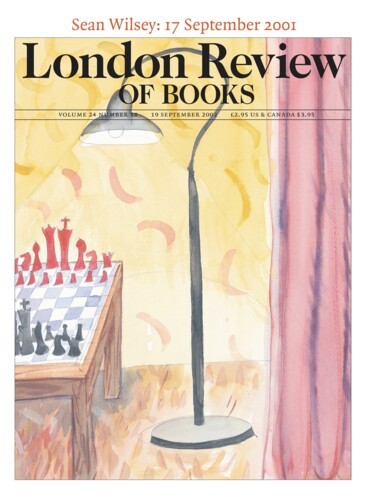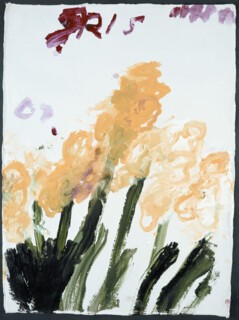Before 1983 the Chelsea Physic Garden was a secret place you glimpsed from the top of a bus passing along the Embankment. Not many got through its gates – one director, at least, took pleasure in turning away grand amateur gardeners. Now it is open to the public (Wednesday and Sunday afternoons). It is still an important botanical resource, but no longer a training ground for apprentice apothecaries, as it was when it was founded in 1673. Lately it has invited artists in to play.
There was a time when they went there to work, as Mrs Elizabeth Blackwell did, to make the five hundred drawings from live plants which illustrate her Curious Herbal (1735). Her efforts helped her husband, who was in prison for debt; he later got caught up in politics and was executed in Sweden. Her engravings are of the competent sort you expect to find in field guides – the apothecaries thought well of them.
But an apothecary, like an amateur naturalist, is interested in quick, accurate identification. Look into one of the serious 19th, 20th (or even 18th) century Floras and you are likely to find few illustrations, and most of them line drawings. Coloured field-guide illustrations allow you to say quickly: ‘Well, it looks a bit like that.’ A full description makes you take things more slowly: count stamens, measure sepals, check smoothness or hairiness and so on. But if the description was adequate the picture was redundant.
More recently it has become possible to look for true identity in genetic make-up. Plant DNA can even be tracked forensically: a French team reckons to be able to identify the grape varieties used in making a bottle of wine – a serious business in a country where diluting good Bordeaux with table wine recently got one dealer an 18-month prison sentence and a $1.2 million fine.
The future of scientific plant identification is in electronic databanks. One result of this move to electronic storage will be that more illustration (whether necessary or not) should become available – most of it photographic, because that is cheap. Is botanical illustration an anachronism which only can survive only as an elegant curiosity?
Probably not, despite its limitations. There are still vacant niches. Illustrations, like all descriptions of plants which aim to assist identification, must choose the degree to which they trade specificity for generality, and even within the genotype there will be chance variations. A description can say ‘pink to red’. An illustrator must make a choice. She can, nonetheless, achieve a degree of generality. Leaves are turned towards you so that you can better appreciate their shape, flowers stripped of dead petals, diseased and insect-eaten parts repaired. It is the parade-ground smartness, and the way every aspect has been displayed (bud, flowers from several angles, maybe bulb, corm or root; adult bird, fledgling, egg), which give natural history illustrations, particularly the best and most famous of them, such elegant formality. These illustrations display the facts about plants and birds as a dancer might display the facts of the human body – clearly and elegantly, if selectively and artificially. Photographs can’t, in the same way, distinguish part from part or distort for the sake of clarity.
The illustrations you find in herbals and field guides simplify and explain in this way. Modest, practical tools, they say a lot quickly. The coloured plates in botanical folios, often devoted to single genera, are similarly helpful. Who were these grand illustrations for? Not botanists. Although they turn up as examples in anthologies of scientific illustration, they have more to do with grand libraries than laboratories. Mendel needed no fine pictures of peas, nor Barbara McClintock of maize. On the other hand, they were (and are) made with an attention to detail and structure which is quite close to that of the botanist who wants to know how a plant develops and what the structural, and even the mathematical, relation between its parts might be. They seem to say: ‘I show not what I saw but what I came to understand.’
This is what distinguishes flower painters from botanical illustrators. The painters show what they see: Fantin Latour’s bunches of roses seem to attend to all those things – softness, fragility, warm shadows – which have no place in, for example, Fitch’s mechanically precise lithographs of rhododendrons. While one could, perhaps, answer a gardener’s question about just what variety a Fantin Latour flower is, the matter seems irrelevant. Cy Twombly (whose flower photographs, sculptures and paintings are on show at Inverleith House in the Edinburgh Botanical Garden until 27 October) is infinitely less specific than Fantin Latour, although the photographs prove that he must be fairly intimate with his subject matter. It is his (the artist’s) rather than evolution’s exquisite invention one is asked to attend to. The vegetable facts he started with are too deeply enmeshed in wandering, planchette-like marks for their botanical correlatives to be guessed at. Grand botanical illustrations, on the other hand, pursued floral facts. They were often a by-product of aristocratic gardening; collectors of rare species commissioned the books and collected them, not botanists. They cared very much about the character of individual varieties. (Similarly, Stubbs’s horses – and his anatomical studies – were a product of British racing, not artistic or even zoological culture.)
The best botanical illustration gets its rhythms and derives its virtue from a subservience to the character of the plant. In the Physic Garden, where an infinitely greater number of species are massed than you would find in any natural landscape, each plant, if you take time to look at it as an individual, asserts its character. Trying to work out what one of the great illustrators would make of it impresses on you how much analytic looking and thinking is required. Whether they are pretty or not becomes unimportant. The Physic Garden has special collections of rare and endangered species from Crete and the Atlantic islands of Madeira and the Canaries. In danger of extinction at home from man and goat, they have found asylum here and are strangely wild things to find so close to well-manicured Chelsea front gardens.
The artists who have been invited to put their pieces up the trees, on the lawns, in the beds of the Physic Garden – perhaps not surprisingly – don’t help explain anything. There are little jokes and playthings. A transparent ziggurat, a what-the-butler-saw box you look into to see pictures of the garden, some casts of marrows and so on. In a different kind of garden some of these pieces might take on the character of the gazebos and temples that dot landscape gardens. But that is gardening; botany is plants. The Physic Garden is botanical not horticultural in its origins and spirit. It is owed the kind of intense, modest attention to the way plants grow which is shown by the best illustration.
Send Letters To:
The Editor
London Review of Books,
28 Little Russell Street
London, WC1A 2HN
letters@lrb.co.uk
Please include name, address, and a telephone number.


